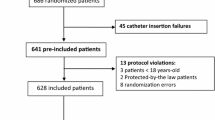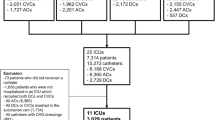Summary
Central venous long-term catheters offer reliable, large-lumen vascular access with high flow rates for delivery of nutrition or for cell-containing infusions and perfusions. Catheter-associated infections (CAI) pose the greatest threat to such vascular access, despite existing preventive measures. In this article one prospective and one retrospective study of CAI in pediatric therapy are presented. Study I: A retrospective investigation from 1990 through 1995 of 60 conventional long-term catheters in 50 patients. The total number of days in which the catheters were in place was 11,818. The calculated CAI incidence was 1 per 1,000 days of catheter insertion. Bacteriologically demonstrated CAI (identical isolate on the catheter tip and in a blood culture) occurred in three instances (5%). Five cases (8.3%) were diagnosed with a therapy-resistant, septic clinical picture. Study II: A prospective, randomized comparison of long-term silver-impregnated (Erlanger silver catheters) and control catheters (Quinton® Instrument Co.) was made with 41 patients (20 with a silver catheter, 21 with a Quinton® catheter). To date, the silver catheters have been distinguished by sterile bacteriological findings, whereas three cases of CAI have been demonstrated with the comparative catheters. One patient recently underwent intensive care after becoming unstable with signs of septic shock and demonstrablePseudomonas aeruginosa, and two other patients manifested coagulase-negative staphylococci on the catheter tips. In three of nine control catheters an incidence of 1.18 per 1,000 days of indwelling catheters was found, whereas no CAI has occurred with the eight microbiologically tested silver catheters.
Similar content being viewed by others
References
Howell, P. B., Walters, P. E., Donowitz, G. R., Farr, B. M.: Risk factors for infection of adult patients with cancer who have tunnelled central venous catheters. Cancer 75 (1995) 1367–1375.
Broviac, J. W., Cole, J. J., Scribner, B. H.: A silicone rubber atrial catheter for prolonged parenteral alimentation. Surg. Gynecol. Obstet. 136 (1973) 602–606.
Hickman, R. O., Bruckner, C. D., Clift, R. A., Sanders, J. E., Stewart, P., Thomas, E. D.: Modified right atrial catheter for access to the venous system in marrow transplant recipients. Surg. Gynecol. Obstet. 148 (1979) 841–845.
Raaf, J. H.: Results from use of 826 vascular access devices in cancer patients. Cancer 55 (1985) 1312–1321.
Lloyd D. A., Shanbhogue, L. K., Doherty, P. J., Sunderland, D., Hart, C. A., Williams, H. F.: Does the fibrin coat around a central venous catheter influence catheter-related sepsis? J. Pediatr. Surg. 28 (1993) 345–349.
Boeswald, M., Girisch, M., Greil J., Spies, T., Stehr, K., Krall, Th., Guggenbichler, J. P.: Antimicrobial activity and biocompatibility of polyurethane and silicone catheters containing low concentrations of silver: a new perspective in prevention of polymer-associated foreign-body infections. Zentralbl. Bakteriol. Int. J. Med. M 283 (1997) 1305–1309.
Maki, D. G., Weise, C. E., Sarafin, H. W.: A semiquantitative culture method for identifying intravenous-catheter-related infection. N. Engl. J. Med. 296 (1997) 1305–1309.
Carbon, R., Baer, K., Thias, M., Huemmer, H. P.: Fibrin sealing in pediatric surgery. Thromb. Haemost. 369 (Suppl.) (1997) 6.
Carbon, R., Schreiber, M., Baer, K., Huemmer, H. P.: Mimimally invasive tissue management with bandage sealing in conventional and minimally invasive surgery. Minimal. Invasive Ther. 6 (Suppl. 1) (1997) 29.
Guggenbichler, J. P., Berchtold, D., Allerberger, F., Bonatti, H., Hager, J., Pfaller, W., Dierich, M. P.:In vitro andin vivo effects of antibiotics on catheter colonized by staphylococci. Eur. J. Clin. Microbiol. Infect. Dis. 11 (1992) 408–415.
Schierholz, J. M., Pulverer, G., Rump, A. F. E.: Katheter-Materialien: Schwierige Suche nach neuen Werkstoffen. Dtsch. Aerztebl. 17 (1998) 813–815.
Johnson, J. R., Roberts, P. L., Olson, R. J., Moyer, K. A., Stamm, W. E.: Prevention of catheter-associated urinary tract infection with a silver-oxide-coated urinary catheter: clinical and microbiologic correlates. J. Infect. Dis. 162 (1990) 1145–1150.
Kamal, G., Ivishek, D., Adams, J., Jebson, P., Tatman, D.: Reduced intravascular catheter infection by routine use of antibiotic bonded catheter. Crit. Care Med. 22 (1993) A115.
Author information
Authors and Affiliations
Rights and permissions
About this article
Cite this article
Carbon, R.T., Lugauer, S., Geitner, U. et al. Reducing catheter-associated infections with silver-impregnated catheters in long-term therapy of children. Infection 27 (Suppl 1), S69–S73 (1999). https://doi.org/10.1007/BF02561623
Issue Date:
DOI: https://doi.org/10.1007/BF02561623




